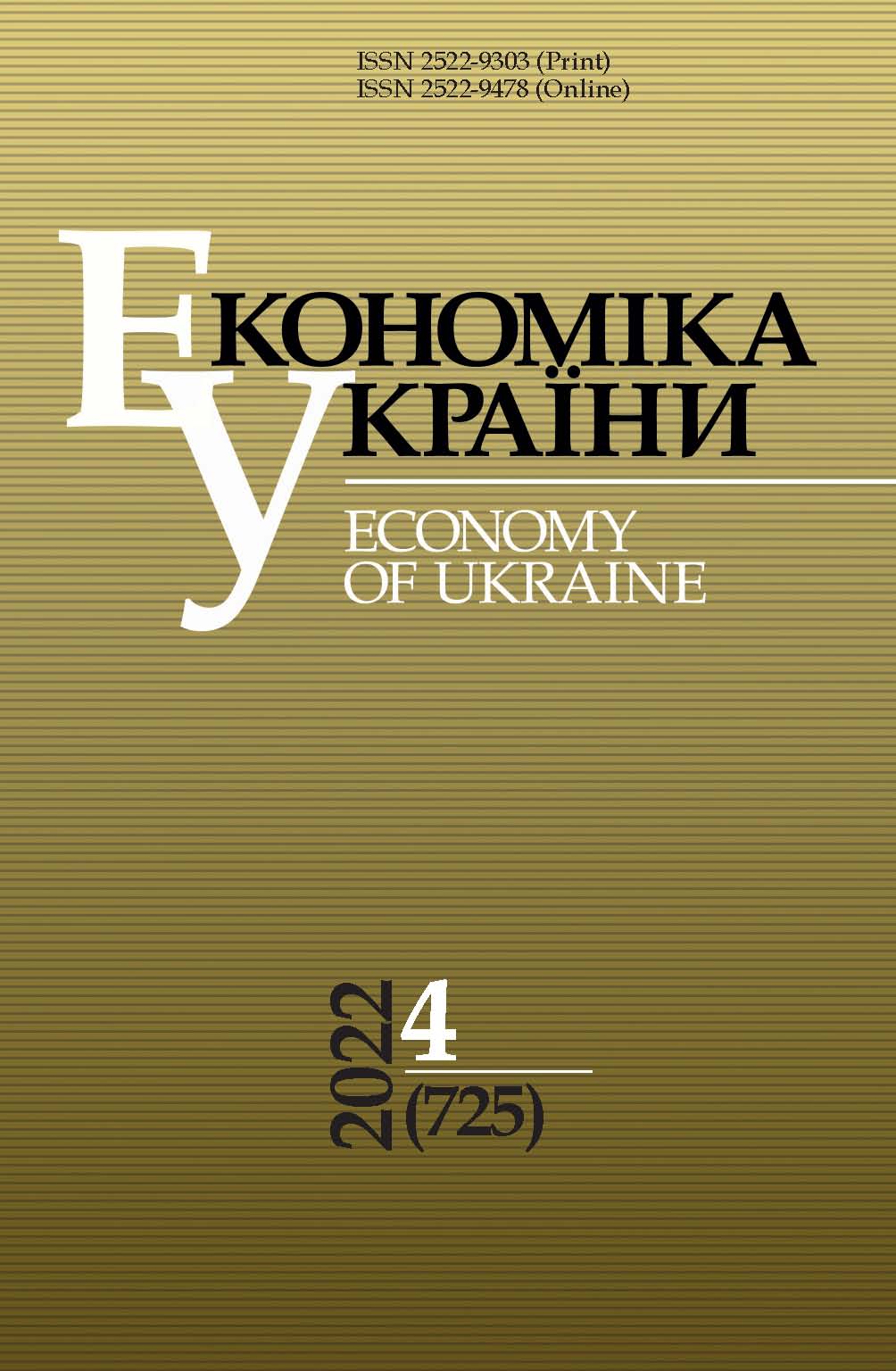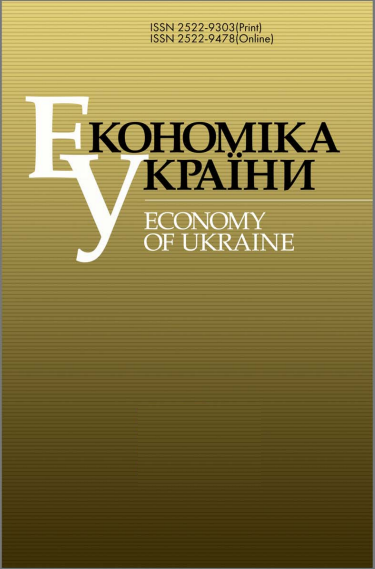THEORETICAL UNDERSTANDING OF THE PROCESSES OF INTEGRATIONDEVELOPMENT IN THE EU AND COOPERATION OF ITS MEMBER COUNTRIES IN THE FIELD OF RESEARCH AND INNOVATION
DOI:
https://doi.org/10.15407/economyukr.2022.04.050Keywords:
European integration; European Union; theory of European integration; crisis processes; disintegration; research and innovation; scenarios for the development of integration in the EU; the war in Ukraine; new historical reality.Abstract
The importance and relevance of theoretical understanding of the problems of initiating and developing the processes of European integration are substantiated. Key theoretical approaches and concepts in the study of European integrationare defined, systematized and revealed, including: federalism, functionalism, neofunctionalism, intergovernmental approach, liberal intergovernmental approach, the concept of political networks, multilevel governance theory, institutional approach, theory of disintegration. The cooperation of European countries in the field of research and innovation is described from the standpoint of several theoretical approaches. It was shown that the foundation of European integration in this area was laid in the early stages of the EU founding, and since then scientific cooperation between countries has been significantly deepened and expanded in both geographical and sectoral terms.
The evolution of theoretical ideas on European integrationis revealed in accordance with the periodization of A. Wiener and T.Diez, who divided these ideas, by historical and substantive contexts, into three phases: explanatory, analytical and constructive. This periodization has been expanded and adapted to modern conditions and challenges, taking into account the crisis processes in the development of the EU, by supplementing it with the fourth phase - disintegration with a period of dominance since 2008 and until now. This name, however, does not imply the inevitable destruction or disintegration of the EU; the generalization of theoretical ideas on disintegration processes indicates a significant discrepancy between the views of authors with Eurosceptic bias, who in their assessments are more inclined to the change or adjustment ofEuropean integration directions according to the newrealities and expectations of countries. Emphasis is placed on the need for theoretical understanding of future scenarios for the development of integration in the EU in the context of the formation of a new historical realityrelated to the Russian military invasion of independent Ukraine.
References
Monnet J. Reality and politics. Memoirs. Moscow, 2000 [in Russian].
Horbulin V. Value resources of war and peace: Ukrainian format. Strategic Priorities, 2018, No. 40 (3), pp. 11-17 [in Ukrainian].
Grytsenko A., Borzenko О., Burlay T. Achievements and challenges of Ukraine's European integration. Journal of European Economy, 2021, Vol. 20, No. 3 (78), pp. 548-572 [in Ukrainian].
doi.org/10.35774/jee2021.03.493
Euro-Atlantic Vector of Ukraine. National Report. S.I. Pyrozhkov, I.O. Kresina, A.I. Kudryachenko, Yu.S. Shemshuchenko et al. (Eds.). Kyiv, 2019 [in Ukrainian].
Melnyk O., Pashkov M., Polyakov L., Sunhurovskyi M. The EU-Ukraine-Security Partnership: Status and Prospects. Kyiv, Razumkov Centre, 2021 [in Ukrainian].
Parakhonsky B., Yavorska G. Destabilizing Europe: Russia's hybrid warfare. Strategic Panorama, 2021, No. 1-2, pp. 5-29 [in Ukrainian].
doi.org/10.53679/2616-9460.1-2.2021.01
Reformatting the European Integration Process: Opportunities and Risks for the Ukraine-EU Association. V. Sidenko et al. (Eds.). Kyiv, 2018 [in Ukrainian].
Ryeznikov V.V. State policy in the field of European integration of Ukraine: theory, methodology, practice. Kharkiv, 2020 [in Ukrainian].
Savelyev Y., Kuryliak V., Lyzun M., Lishchynskyy I. Concept "Visegrad Four + Ukraine": the reality and prospects. Herald of the Economic Sciences of Ukraine, 2019, No. 1 (36), pp. 115-121 [in Ukrainian].
Sidenko V.R. The crisis processes in the EU development: origins and prospects. Economy and Forecasting, 2017, No. 1, pp. 7-30 [in Ukrainian].
doi.org/10.15407/eip2017.01.007
Civilizational choice of Ukraine: paradigm of comprehension and strategy of action. National Report. S.I. Pyrozhkov, O.M. Mayboroda, Yu.Zh. Shayhorodskyi et al. (Eds.). Kyiv, 2016 [in Ukrainian].
Diez T., Wiener А. Introducing the Mosaic of Integration Theory. KFG Working Paper Series, 2018, No. 88, May. Freie Universität Berlin, 2018.
doi.org/10.1093/hepl/9780198737315.003.0001
McCormick J. European Union Politics. London, Palgrave Macmillan, 2011.
doi.org/10.1007/978-0-230-34391-7
Mitrany D. A Working Peace System: An Argument for the Functional Development of International Organization. London, Royal Institute of International Affairs, 1943.
Haas Ernst B. The Uniting of Europe: Political, Social, and Economic Forces, 1950-1957. Foreword by Desmond Dinan. New Introduction by Ernst B. Haas. Notre Dame, Indiana, University of Notre Dame Press, 2004.
Hoffman S. The European Sisyphus: Essays on Europe, 1964-1994. San Francisco, Westview Press, 1995.
Moravcsik A. Preferences and Power in the European Community: a Liberal Intergovernmentalist Approach. Journal of Common Market Studies, 1993, Vol. 31 (4), pp. 473-524.
doi.org/10.1111/j.1468-5965.1993.tb00477.x
Börzel T. Organizing Babylon - on the Different Conceptions of Policy Networks. Public Administration, 1998, Vol. 76, No. 2, pp. 253-273.
doi.org/10.1111/1467-9299.00100
Amosha O., Pidorycheva I., Zemliankin A. Key trends in the world economy development: new challenges and prospects. Science and Innovation, 2021, Vol. 17, No. 1, pp. 3-17.
doi.org/10.15407/scine17.01.003
Slaughter A.-M. The Real New World Order. Foreign Affairs, 1997, Vol. 76, No. 5, pp. 183-197.
doi.org/10.2307/20048208
Marks G. Structural policy in the European community. In: Europolitics: Institutions and Policymaking the 'New' European Community. A.M. Sbragia (Ed.). Washington, DC, The Brookings Institute, 1992, pp. 191-224, available at: garymarks.web.unc.edu/wp-content/uploads/sites/13018/2016/09/marks-Structural-Policy-in-the-European-Community.pdf
Marks G. Structural policy and multilevel governance in the EC. In: The State of the European Community. A.W. Cafrany, G.G. Rosenthal (Eds.). Boulder, CO, Lynne Riemer, 1993, pp. 391-409, available at: garymarks.web.unc.edu/wp-content/uploads/sites/13018/2016/09/marks-Structural-Policy-and-Multilevel-Governance.pdf
Hooghe L., Marks G. Multi-Level Governance and European Integration. Maryland, Rowman & Littlefield Publishers, 2001.
Pidorycheva I. Scientific-technological and innovative cooperation between Ukraine and the European Union: perspectives and strategic directions of development. Economy of Ukraine, 2022, No. 2, pp. 50-74 [in Ukrainian].
doi.org/10.15407/economyukr.2022.02.050
Chesbrough H. Open Innovation: The New Perspective for Creating and Profiting from Technology. Boston, Massachusetts, Harvard Business School Press, 2003.
Ladrech R. Europeanization of Domestic Politics and Institutions: The Case of France. Journal of Common Market Studies, 1994, Vol. 32 (1), pp. 69-88.
doi.org/10.1111/j.1468-5965.1994.tb00485.x
Radaelli C.M. The Europeanization of Public Policy. In: The Politics of Europeanization. K. Featherstone, C. Radaelli (Eds.). Oxford, Oxford University Press, 2003, pp. 27-56, available at: ceses.cuni.cz/CESES-93-version1-4_1_1.pdf
doi.org/10.1093/0199252092.003.0002
Wiener A., Diez T. European Integration Theory. New York, Oxford University Press, 2009.
Hempson III Donald A. European Disunion: The Rise and Fall of a Post-War Dream? Origins: Current Events in Historical Perspective, 2013, July, available at: origins.osu.edu/article/european-disunion-rise-and-fall-post-war-dream?language_content_entity=en
Scheller H., Eppler A. European Disintegration - Non-existing Phenomenon or a Blind Spot of European Integration Research? Preliminary Thoughts for a Research Agenda. Institute for European Integration Research. Working Paper, 2014, No. 02.
European Disunion: Between Sovereignty and Solidarity. J. Hayward, R. Wurzel (Eds.). New York, Palgrave Macmillan, 2012.
Woods N. The European Disunion: How the Continent Lost its Way. Voices, 2015, 18 Dec, available at: www.bsg.ox.ac.uk/blog/european-disunion-how-continent-lost-its-way
Vollaard H. Explaining European Disintegration. Journal of Common Market Studies, 2014, Vol. 52 (5), pp. 1142-1159.
doi.org/10.1111/jcms.12132
Schmitter P. European Disintegration? A Way Forward. Journal of Democracy, 2012, Vol. 23 (4), pp. 39-48.
doi.org/10.1353/jod.2012.0070
Vollaard H. European Disintegration: A Search for Explanations. London, Palgrave Macmillan, 2018, available at: link.springer.com/content/pdf/bfm%3A978-1-137-41465-6%2F1.pdf
Jones E. Towards a theory of disintegration. Journal of European Public Policy, 2018, Vol. 25 (3), pp. 440-451.
doi.org/10.1080/13501763.2017.1411381
Webber D. How likely is it that the European Union will disintegrate? A critical analysis of competing theoretical perspectives. European Journal of International Relations, 2013, Vol. 20 (2), pp. 341-365.
doi.org/10.1177/1354066112461286
Schimmelfennig F. EU crisis and reform: is differentiated integration the answer? Groupe d'études géopolitiques. Working Paper, 2020, June, available at: legrandcontinent.eu/fr/wp-content/uploads/sites/2/2020/06/GEG_EU-crisis-and-reform-is-differentiated-integration-the-answer.pdf
doi.org/10.2139/ssrn.3630292
Charlemagne. The return of Jaques Delors. The Economist, 2004, 12 Feb, available at: www.economist.com/europe/2004/02/12/the-return-of-jacques-delors
Berend I.T. The Contemporary Crisis of the European Union: Prospects for the Future. Abingdon, Oxon; New York, Routledge, 2017.
Soros G., Schmitz G. The Tragedy of the European Union: Disintegration or Revival? New York, Public Affairs, 2014.
Downloads
Published
How to Cite
Issue
Section
License
Copyright (c) 2022 Institute for Economics and Forecasting of the NAS of Ukraine

This work is licensed under a Creative Commons Attribution-NonCommercial-NoDerivatives 4.0 International License.



